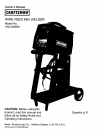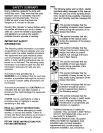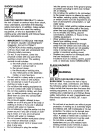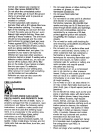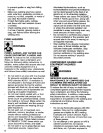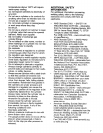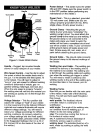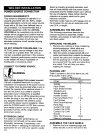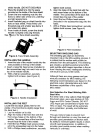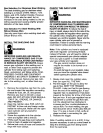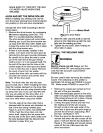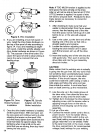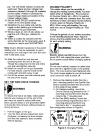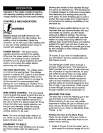
temperatures above 130°F will require
water spray cooling.
• Do not expose cylinders to electricity of
any kind.
Do not use a cylinder or its contents for
anything other than its intended use. Do
not use as a support or roller.
• Do not locate cylinders in passageways
or work area where they may
be struck.
• Do not use a wrench or hammer to open
a cylinder valve that cannot be opened
b3i-hand. Notify your supplier.
• D_ not modify or exchange gas
cylinder fittings.
• Do not deface or alter name, number or
other markings on a cylinder. Do not rely
on cylinder color to identify
the contents.
• Do not connect a regulator to a cylinder
containing gas other than that for which
the regulator was designed.
Do not attempt to make regulator repairs.
Send faulty regulators to manufacturer's
designated repair center for repair.
• Do not attempt to lubricate a regulator.
Always change cylinders carefully to
prevent leaks and damage to their walls,
valves, or safety devices.
Always secure cylinders with a steel chain
so that they cannot be knocked over.
• Always protect a cylinder, especially the
valve, from bumps, falls, falling objects
and weather. Remember that gasses in
the cylinders are under pressure and
damage to a regulator can cause the
regulator or portion of the regulator to be
explosively ejected from the cylinder.
Always make certain the cylinder cap is
securely in place on the cylinder,
whenever the cylinder is moved.
Always close the cylinder valve and
immediately remove a faulty regulator
from service, for repair, if any of the
following conditions exist.
• Gas leaks externally.
Delivery pressure continues to rise with
down stream valve closed.
• The gauge pointer does not move off the
stop pin when pressurized or fails to
return to the stop pin after pressure is
released.
ADDITIONAL SAFETY
INFORMATION
For additional information concerning
welding safety, refer to the following
standards and comply with them as
applicable.
• ANSI Standard Z49.1 - SAFETY IN
WELDING AND CUTTING - obtainable
from the American Welding Society, 550
NW Le Jeune Road, Miamil FL 33126
Telephone (800) 443-9353,
Fax (30_) 443-7559 - www.amweld.org
or www.,_ws:org
• ANSI Standard Z87.1 - SAFE PRAC-
TICE FOR OCCUPATION AND
EDUCATIONAL EYE AND FACE
PROTECTION - obtainable from the
American National Standards Institute,
11 West 42nd St., New York, NY 10036
Telephone (212) 642-4900,
Fax (212) 398-0023 - www.ansi.org
• NFPA Standard 51B - CUTTING AND
WELDING PROCESS - obtainable from
the National Fire Protection Association,
1 Batterymarch Park, P.O. Box 9101,
Quincy, MA 02269-9101
Telephone (617) 770-3000
Fax (617) 770-0700 - www.nfpa.org
• OSHAStandard 29 CFR, Part 1910,
Subpart Q., WELDING, CUTTING AND
BRAZING - obtainable from your state
OSHA office or U.S. Dept. of Labor
OSHA, Office of Public Affairs, Room
N3647, 200 Constitution Ave.,
Washington, DC 20210 - www.osha.gov
• CSA Standard Wl17.2 - Code for
SAFETY IN WELDING AND CUTTING. -
obtainable from Canadian Standards
Association, 178 Rexdale Blvd.,
Etobicoke, Ontario M9W 1R3 -
www.csa.ca
American Welding Society Standard
A6.0. WELDING AND CUTTING
CONTAINERS WHICH HAVE HELD
COMBUSTIBLES. - obtainable from the
American Welding Society, 550 NW Le
Jeune Road, Miami, FL 33126
Telephone (800) 443-9353,
Fax (305) 443-7559 - www.amweld.org
or www.aws.org
7



